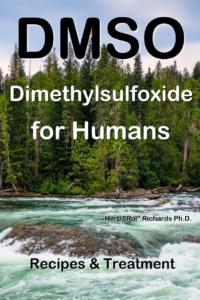DMSO
by TVance | March 1, 2022 3:54 pm
DMSO is a natural solvent derived from trees. The purpose of this natural chemical appears to be to deliver nutrients throughout the tree and to protect the tree from the adverse effects of extreme temperatures, like a natural antifreeze.
 [1]
[1]
Hospitals carry a pharmaceutical grade of DMSO that is administered to treat interstitial cystitis and for treating damage due to cancer radiation as these are the only uses for humans approved by the FDA. Veterinarians use DMSO to treat animals, mostly in equine care and to a lesser extent, canine, feline, and in treating livestock.
 [2]There are a growing number of natural alternative specialists that are embracing this product to treat humans for various types of maladies, which is not sanctioned by the FDA, and could end up costing doctors their licenses if they suggested using DMSO for any unauthorized purpose.
[2]There are a growing number of natural alternative specialists that are embracing this product to treat humans for various types of maladies, which is not sanctioned by the FDA, and could end up costing doctors their licenses if they suggested using DMSO for any unauthorized purpose.
As a life-sustaining facilitator, it is used to preserve tissue during the transport of organs for transplant, and is rumored to possess healing properties. And it appears to act both as an antifreeze and distribution method for other substances in humans, just like it does for the trees it comes from.
Interestingly, you can apply a substance with DMSO directly to the surface area of the skin, and it will take the substance (nutrient or medicine) through the protective layers of the skin, through the underlying tissue, into the bone and/or the bloodstream with the same speed and efficacy of an IV, without any injection.
Amandha Vollmer, author of Healing with DMSO[3], provides a DMSO concentrations chart for various dilutions of DMSO.
| 99.995% | Pharmaceutical-grade format should not be used in at-home first-aid situations. Though it can be used purely on the skin only for emergency situations, it should only be used with the help of a natural health practitioner. Redness, hives, and itchiness will be experienced. If used repeatedly on the same area of skin, the area will thicken, look leathery, and eventually peel. This is a side effect and once DMSO use is halted, the skin will return to normal, and often in a better condition than before. |
| 90% | This is the strength often sold in health food stores either diluted with distilled water or with preservative-free aloe vera gel. At this strength, redness, burning, and itchiness can be experienced. It is also important to note that this percentage may be too strong for certain skin types. Repeated use at this strength can also lead to a thickened, leathery skin texture. Do not use this strength on delicate skin, like on the face. As mentioned earlier, my usual recommended percentage range is 40 to 30 percent, and I would generally recommend avoid applying a 90 percent strength concentration in at-home situations. |
| 80% | This percentage is effective for skin applications blended with distilled water or preservative-free aloe vera gel juice. It is also an optimal percentage to use if mixing with other nutrients like vitamins, minerals, or botanical extracts. This is an ideal percentage for topical treatment of muscle injuries. |
| 70% | Ideal for those who still find an 80 percent concentration too strong for topical use. Also excellent for making DMSO blends. Added to distilled water, this is a great percentage to use for pain and to help the DMSO penetrate deeper, as it uses water as a propeller to move deeper into tissues. This percentage or lower is best to use topically for tendons, ligaments, nerves, bone, or any region with less water content. |
| 60% | The topical percentage for more delicate skin or those very sensitive to DMSO. Use similarly to the 70 tp 80 percent solutions. |
| 50% | This is the maximum strength that should be used for the scalp, eyes and ears, ingested, and in a nebulizer. It can still feel very strong for these areas, so it is recommended to start with a weaker dilution first to test sensitivity or to slowly work up to a 50 percent dosage. This is also the maximum dose for oral use. Can be used on wounds and to assist hair to regrow or thicken. |
| 40% | This dilution is safe for eyes (prepared in saline solution) and ears. I recommend this as a percentage for use on the face and other delicate skin. |
| 30% | This dilution can also be used for the face, eyes, ears, and ingestion. Thirty percent DMSO in saline is a very good anti-inflammatory eyedrop solution for the eyes. |
| 20% | This is the beginner level for eyes drops and ear drops. This percentage is also safe for animals and children and a great place to start to patch test for a sensitivity response. |
| 10% | Use at this concentration if you wish to enhance the absorption of liquid formulas. At this low strength, DMSO is not used therapeutically. At this concentration or less, it is used to mix with chlorine dioxide solution. |
Dimethyl Sulfoxide (DMSO[4]) may be invaluable as an alternative healing compound worth additional research.
What do you think?
- [Image]: https://topsellerbestsellers.com/products/dmso-topical-penetrant-solution-tps-16-oz-99-99-pure
- [Image]: https://topsellerbestsellers.com/collections/dmso/products/dmso-dimethylsulfoxide-for-humans-recipes-treatment-prerelease
- Healing with DMSO: https://www.amazon.com/Healing-DMSO-Treatments-Inflammation-Sulfoxide/dp/1646040023/ref=nosim?tag=stpaulsfree-20
- DMSO: https://topsellerbestsellers.com/products/dmso-topical-penetrant-solution-tps-16-oz-99-99-pure
Source URL: https://alternativeresourcesdirectory.com/health/dmso